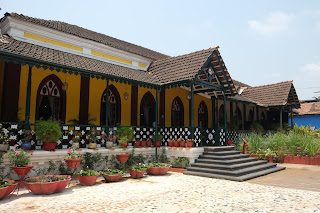First to Dubai, United Arab Emirates. As we sailed in, we were hoping to see that famous Dubai skyline, topped by the Burj Khalifa, the tallest building in the world. What we actually saw was a hazy skyline, but the Burj definitely stood out. They say that the top of the Burj tower is not entirely complete because if someplace builds a taller tower, they'll go up and add another meter or so to stay ahead of the competition.
We spent the day on board, and in the evening we were treated to a barbeque out in the dunes. We were looking for one of those beautiful desert sunsets but all we got was the sun sinking slowly into the haze. We had a wonderful buffet and the entertainment included fire eating, belly dancing (so much for Muslim modest dress), and more.
And then there were the camel rides...
Returning to the ship at night, again we were hoping for a very brightly lit skyline, but, nope. Even the Burj isn't lit up very well. Miami's much better. OK, onward to Abu Dhabi.
Abu Dhabi's a lot like Dubai, only bigger and hazier. The big draw for tourists is the Sheikh Zayed Grand Mosque, opened about eight years ago and almost the only mosque that allows visitors. To get in, one must first pass "security", that is, a check to ensure that everyone is obeying the dress code. No shorts or tank tops for men. Ankles and arms covered for women, and hair under a scarf. Not a hat, no, that won't do. It has to be a scarf. Pati donned the "hijab" over the hat and plowed ahead.
This is really a show place. The carpet in the main room is silk, hand woven by over 1,000 women. It covers a space big enough to fit 10,000 men, is only in three parts, and weighs 40 tons. There are a number of absolutely huge chandeliers made from Murano glass and Swarovski crystal, and the overall design is that of a garden. Heaven is supposed to be a garden. Apparently, the garden would belong to a very wealthy individual.
We also cruised around town for other views that included the high-rent district, the Emirates Palace Hotel, and the Presidential Palace. There's a lot of money in the Emirates, that's for sure. Abu Dhabi is home to the Yas Marina race circuit and Ferrari World. We were surprised that none of the tours went there! We returned to the ship, hoping again for a good sunset. The sun sank slowly into the haze.
And then the fun began. A day at sea aimed us for Salalah, Oman. During our sea day, we were introduced to the procedures for sailing near the pirate coast off northern Africa. First, we stopped out in the ocean, were met by a small boat, and brought aboard several large black boxes. Some guessed that they contained champagne, some guessed cigars, others thought it was fresh fish, but most guessed weapons. Next came the drill..."Code Orange Papa! Safe Haven!" Everyone close the curtains, get out of the rooms, away from the windows, and into the corridors. We're going to maneuver! Everyone lie down on the floor! No, don't do it now! We're just telling you!
Outside on deck, most of the lights were off at night, and curtains closed all around the ship. No lights on in the suites with the curtains open. The fire hoses were rigged up and ready to go, and scarecrow-like dummies stood the watch on deck six, 24/7. The security people were actually pretty busy keeping a real 24/7 watch. It was formal night. Gordon's tuxedo included an appropriate bow tie decorated with Jolly Rogers. And the sun sank slowly into the haze.
Reaching Salalah, we had had enough of oppressive heat and humidity, sand, camels, and mosques, so we stayed aboard for the day. And the sun sank slowly into the haze. Next came four days at sea, headed for the Red Sea and Jordan. On the third day, after a champagne and caviar breakfast, we were met by a well-used naval patrol boat and relieved of the mysterious black boxes via two dudes in a Zodiak. Guess what the sun did. Next stop was Aqaba, Jordan unless we wind up in Ethiopa with Starvin' Marvin.










































